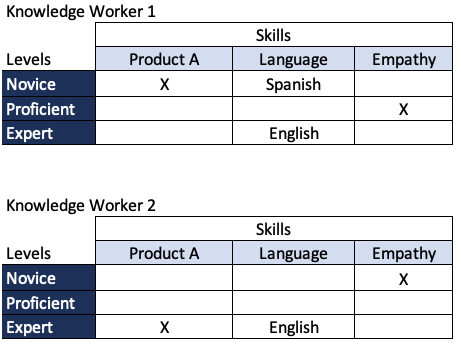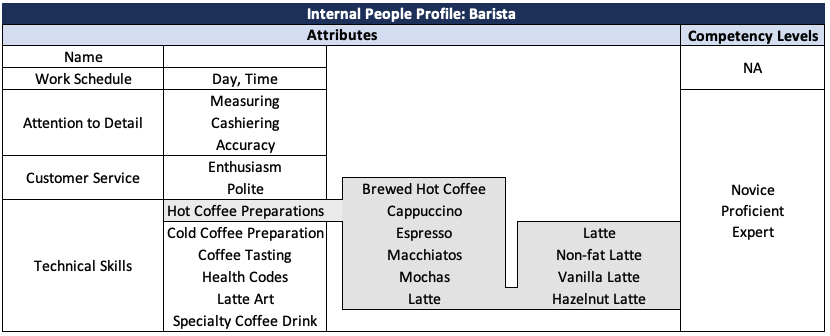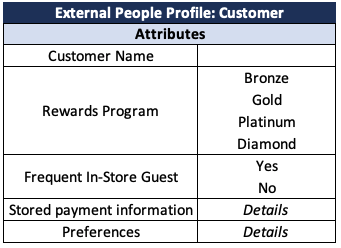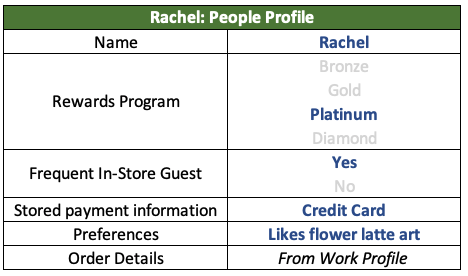People Profiles
The Practices of Connect and Collaborate depend on knowing a lot about the people interacting and the nature of the work. We can only make relevant connections between work and people, and people and people, if we have a robust and dynamic understanding of a common set of attributes. We achieve a common set of attributes by building People Profiles.
Building People Profiles is mostly a method by which we are pulling data from the right places - not creating a separate object.
Profile Types - Internal and External
Ideally, we would build a single People Profile that maintains ALL of the attributes for people regardless of their role or location in the system, but we often know far more about our employees than we know about our customers or other external people. Therefore, it is helpful to talk about them as separate types of People Profiles.
- An Internal Profile is a collection of the attributes of the people internal to our organization or company. This may include employees, contractors, and outsource partners who are in the company network. Sometimes referred to as a knowledge worker profile.
- An External Profile is a collection of the attributes of the people who are outside the organization, who use our products or services. In our context, these are the attributes we need to know about people making requests for help from outside the company.
People often play requestor or responder roles in the system that is not related to their Internal or External designation. A requestor can be an internal or external resource who is making a work request (opening a service request/incident/case, or an internal resource requesting help with existing work). A responder may be an internal or external resource who is responding to a request. Most often, we refer to the responder as an internal person responding to a customer (external) request. However, in online communities or forums, external people are playing both the role of requestor and responder.
Internal Profiles
Finding the best person to handle a request, as well as finding the best person to assist quickly, drives efficiency in an Intelligent Swarming system. Today, certain people play the role of connector; there is often someone in the organization who is the go-to person to find out who knows what. This may work on a small team, but it becomes problematic when the team is large or distributed, or when an expert is situated outside the team. Additionally, the team may depend too much on one person as a resource, while there are other team members who could help. Having visibility to the capabilities of the whole team allows people to find the best person available to help solve an issue and gives others than the "expert" a chance to contribute. People Profiles are a knowledge asset that has great value in facilitating collaboration.
Designing Internal Profiles
People are dynamic: always learning and adapting to an ever-changing environment. This means that the attributes of the People Profile are not static - they change to reflect the most current needs of an organization.
Designing what to capture in a People Profile should happen in the context of the organization's goals. Consider what skills, competencies, and knowledge is necessary for the business, both today and in the future:
- What [organization / team] results are we after?
- What behaviors / activities are we trying to encourage?
- What skills / competencies are important?
- What do we need to know about others that would help us collaborate more effectively?
- How do we reflect the history of the value people create?
Limiting our thinking to just the technical skills needed to support a specific product or application greatly limits how people contribute and succeed. In a robust Intelligent Swarming system, profiles need to be broad and inclusive.
Start Manually: Document the core required elements of an Internal Profile. This can be done by individuals, by individuals with manager input, or as a team. Teams often quickly identify which employees are experts or novices in what areas.
Mature the Profile: As we gain experience with Internal Profiles, we may need to capture more detail or change what we are capturing entirely. Profiles are a living part of Intelligent Swarming that need to be updated and maintained as skills, capabilities, and knowledge change. Ultimately, use automation to update People Profiles to streamline maintenance and help keep profiles dynamic.
Based on experience with Intelligent Swarming to date, the emerging best practice is to start with simple profiles and make them more robust with use. This prevents over-engineering at the outset and allows for growth as we discover what we need through experience with the system.
The ultimate goal is to have the skills aspect of People Profiles created and maintained as a by-product of the content that individuals interact with. The skills a person possesses can be inferred from the knowledge articles they authored or referenced, cases they solved, and training or certifications they have received.
Dimensions of Internal Profiles
A well-designed internal profile is multidimensional, based on many elements that make up well-rounded knowledge workers as people. Both broad and deep skills, and the competency levels in those skills, adds a level of detail to our understanding of people's capabilities that are not captured with tiers or even job titles. Being an expert in one area does not mean being an expert in all areas. We need to know the diverse skills and levels of expertise to best match work to people and people to people.
CAUTION: not all profiles should look the same. There have been instances where companies begin to use profiles as performance or success indicators. We need a diverse workforce with diverse profiles to be successful; one profile is not better than another.
As we discussed in Skills Development & Utilization, we are looking to build T-shaped people. If we don't have T-shaped people, we can create T-shaped capability through collaboration. T-shaped people have deep expertise in at least one discipline or domain, as well as an understanding of the bigger picture and a number of broad or transferable skills.
Deep skills are knowledge and expertise related to a specific domain. These can be taught and measured. Deep skills are the specific functional skills needed to get the job done such as a thorough understanding of a product, technology, process, or policy.
Broad skills are the skills or talents people need to engage, collaborate, and communicate. Examples of broad skills include empathy (for the customer and their experience), project management, effective communication in multiple contexts, and ability operate at different levels of abstraction. These are a combination of skills, personality traits, and attitude, which makes these broad, transferable skills less tangible and harder to measure.

Elements of Internal Profiles
The profile of a person can be endless and expansive. For the intent of Intelligent Swarming, there are key elements that need to be captured to support the Practices of Connect and Collaborate, along with providing context for Recognize.
How much detail to capture in the Internal Profile depends on the complexity of each company's environment. What can be captured may be endless, but there is a balance that needs to be found. A good way to think about the level of detail needed is asking:
- What do we need to know about people to enable "first touch relevance"?
- What would we like to know about others that would help us collaborate more effectively?
- What level of detail can be maintained and updated to be accurate and relevant at all times?
At a minimum, the Internal Profile contains:
Identity & Preferences
Identity and preferences are often the easiest parts of the profile to identify and collect, but are often overlooked. In almost all organizations, this information is already captured and relatively easy to come by. It may include:
- Contact Information
- Name
- Location (region, office, etc)
- phone number, email address, collaboration tool name
- Time of day available
- Preferred contact method
- Languages spoken
Preferences enable the knowledge worker to declare a number of things like preferred language or preferred mode of contact. This information may also include the type of role the person has on the team.
Skills
Skills, centered around abilities to perform a task, should include both deep skills (subject domain expertise) and broad skills (transferable skills: interpersonal skills, project management, problem-solving). Most organizations have a starting point for understanding individual skills. We have either documented or have a strong sense of the technologies that the organization supports and the related technical skills needed. Sources to use for creating well-rounded internal profiles may include:
- Job title (and perhaps a link to the job description)
- Information in CRM systems
- Skills-based routing profiles
- New hire training material
- Existing certifications
- Work people are doing today
When documenting required skills, remember both technical or subject matter skills and broad transferable skills are important. We want to identify all of the skills in the organization that make us successful.
Examples of Skills


Competency Levels
We need a thorough and accurate view of individual competencies in the defined skills to optimize relevant visibility.
For each of the skill areas (deep and broad), we want to know at what level the employee operates. Two people with the same skill may have different levels of ability within that skill. When designing levels, we need to define what the different competency levels look like and how many levels we need to allow for progression - without so many levels that the difference becomes muted. From the experiences to date, three to six levels seems to be the sweet spot, with three in small or less mature environments and up to six in well-established organizations. The number of levels depends on a company's culture, environment, and career path objectives.
Example Competency Levels

It is critical that everyone knows the criteria for the competency levels and that any subjectivity is kept to an absolute minimum. Documenting the characteristics across three dimensions is an excellent technique to ensure transparency.
What a person at each level:
- Understands ________
- Knows how to ________
- Can do _______
An example worksheet with three levels and four transferable skills:

There are many great examples of how competency levels and skills are used to define a person's capability. Lean Six Sigma Belts are one very well-defined and mature example. This is also a great tool to use in creating Badges and a Reputation Model, which are components of a profile.
Interests
In the Interest part of the profile, a knowledge worker indicates those skill areas that they would like to develop. Interests may include new products, technologies, business processes, or developing specific broad, transferable skills.
Interests play an important role in an Intelligent Swarming system as they enable visibility to work that will advance and expand a knowledge worker's skills. If we don't balance existing skills with interests in our visibility engine, knowledge workers will only get better at the things they are already good at; it creates over-specialization. Including interests in profiles ensures the system is designed in such a way that skills development is happening, and taps into the motivation factors of both autonomy (people indicate their own interests) and mastery (people are provided an opportunity to get better at the things they are interested in).
Reputation
Reputation Models are still an emerging technique in Intelligent Swarming and one that companies struggle with. There are great examples of why a reputation model is so impactful and is a powerful tool for Intelligent Swarming. See Reputation Models for more details around reputation and reputation models.
Maintaining Internal Profiles
Maintaining profiles is key to ensuring that we think of them as living documents that are always changing as the attributes of people change. If it’s not possible to update the profiles automatically, make a plan for how to keep the profiles up to date. Who will do this? How often will it be done? It is recommended to update the profile at least every quarter, but that really depends on the dynamics of the work. Annual performance reviews can be a good moment to look at the profile and, if necessary, update skill levels. Updates can also be done by others; for example, co-workers who rate the skill level after collaboration. This can be linked to a recognition system.
External Profiles (Customer/Requestor)
In an ideal environment, we would be able to know as much about the external person who makes a request as we do about internal knowledge workers. Creating robust profiles of the external people (often our customers) is as important as the internal profile in facilitating the process of matching people to people and people to work. It is difficult to know as much about external people as we do about the people in our organization. However, organizations often know more about customers than they realize, and starting to capture what is known will greatly enhance an Intelligent Swarming system. Online communities or forums are a potential source to consider for information about external people. An active online community provides an opportunity to learn a lot about the skills of those who are active in the community.
Required Information for an External Profile
Identity
- Name
- Phone number
- Company
Preferences
- Preferred communication method (live call, email, chat)
- Working hours (based on location or specific)
- Language required and/or preferred
Customer Entity Details
Additional attributes, if applicable, can be tracked about the requestor that help us with visibility.
- Service Contract
- Service Levels (basic, premium, etc)
- Service Level Agreements
- Products / Services purchased or included in a subscription
- Installed
- Not installed
- Where in the lifecycle of an Implementation the customer is
Enhanced Information for an External Profile
Skills & Competency
While we rarely know all of the skills and competencies of external people, we can often infer many of their skills based on the history of work. For external people who frequently contact a service group as a requestor, knowledge workers often know and build relationships with them, but rarely capture this detail for others.
For example, if an external person requests assistance in a certain topic or product area and we know from past experience that they have searched the knowledge base, done significant pre-work, and/or taken relevant training, and their requests typically need highly skilled people to resolve, it is reasonable to assume that person has skills in that area.
Capturing this level of detail in an external profile will enhance our ability to connect them with the more relevant resource to resolve their issue.
Every interaction is an opportunity to improve the experience and efficiency of the next interaction.
Maintaining External Profiles
Ideally, we maintain external profiles in the same way that we hope to automatically update internal profiles based on the work they do and the content they interact with. In the meantime, we implore responders to capture relevant information and updates about the requestor in the workflow over the course of their interaction.
People Profiles in Action
Morning Coffee Example
Let's see what People Profiles might look like in the example of a busy café. A customer places an order for a non-fat latte; we need to know the skills and competencies of the baristas that will interact with each other and with the customer to complete this request.
Let's look at what Internal and External People Profiles might look like in this interaction where we expand the Attributes for the latte.


In this example, we have two baristas, Gunther and Joey, and one customer, Rachel. Each profile will be unique to the individual. 

